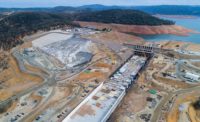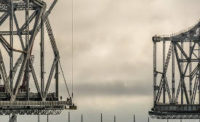California’s largest dam removal project ever will take advantage of the area’s unique topography to allow builders to permanently divert the Carmel River into a new channel.


Built in 1921 about 18.5 miles upstream of the Pacific Ocean in Monterey County, the 106-ft-tall San Clemente Dam has filled with 2.5 million cubic yards of sediment, and is at risk of failure during an earthquake or probable maximum flood (PMF).
Under a $61-million design-build contract, crews with Granite Construction, Watsonville, will cut a 400-ft diversion channel through a small ridge separating the Carmel River and tributary San Clemente Creek .5 mi above the dam.
Dam owner California American Water looked at multiple options, including buttressing. But state agencies and environmental groups sought a solution that would open up 25 miles of upstream habitat for migrating steelhead trout and other species.
“Initially we went through different alternatives for the removal process, but we always got stuck on the sediment,” says Rich Svindland, vice president of engineering. “Ultimately, one of our employees came up with the idea to reroute the river around the sediment, and leave the sediment in place.” At a total project cost of $83 million, the solution was more expensive than buttressing, but various public partners pitched in the additional funds to facilitate the removal and habitat restoration.
Engineers aren't sure how the creekbed and slopes will handle the increased flows because the soils have been hidden under the reservoir for so long. Additional geotechnical work will be ongoing during the next year. The team could use rock anchors and concrete chutes to ensure slope stability, but that wouldn’t be appropriate for habitat restoration, Svindland says. “We have to make it look like nature made it, not man, and then still meet the California Division of Safety of Dams criteria to pass the PMF,” he adds.
During the three-year project, crews will build access roads, lower or notch the dam to gradually dewater the reservoir and excavate 380,000 cu yds of silt from the creekbed to add to the sediment along the old Carmel River channel. The dam itself won’t be demolished until the tail end of the project.
The stockpiled material will be held in place during seismic events and floods, sandwiched between a dike upstream composed of rock excavated during the cut and another rock-filled engineered earthen dam downstream. The sediment will be contoured and landscaped to create upland habitat typical for the area. The team will monitor the project for several years to ensure that the resulting habitat is stable.
Owners of other heavily silted dams will watch the San Clemente Dam project with interest. “We happened to be fortunate in the layout of the land up there, but hopefully it can help people rethink the dilemma of how to deal with sediment,” says Catherine Bowie, California American Water’s external affairs manager.




Post a comment to this article
Report Abusive Comment